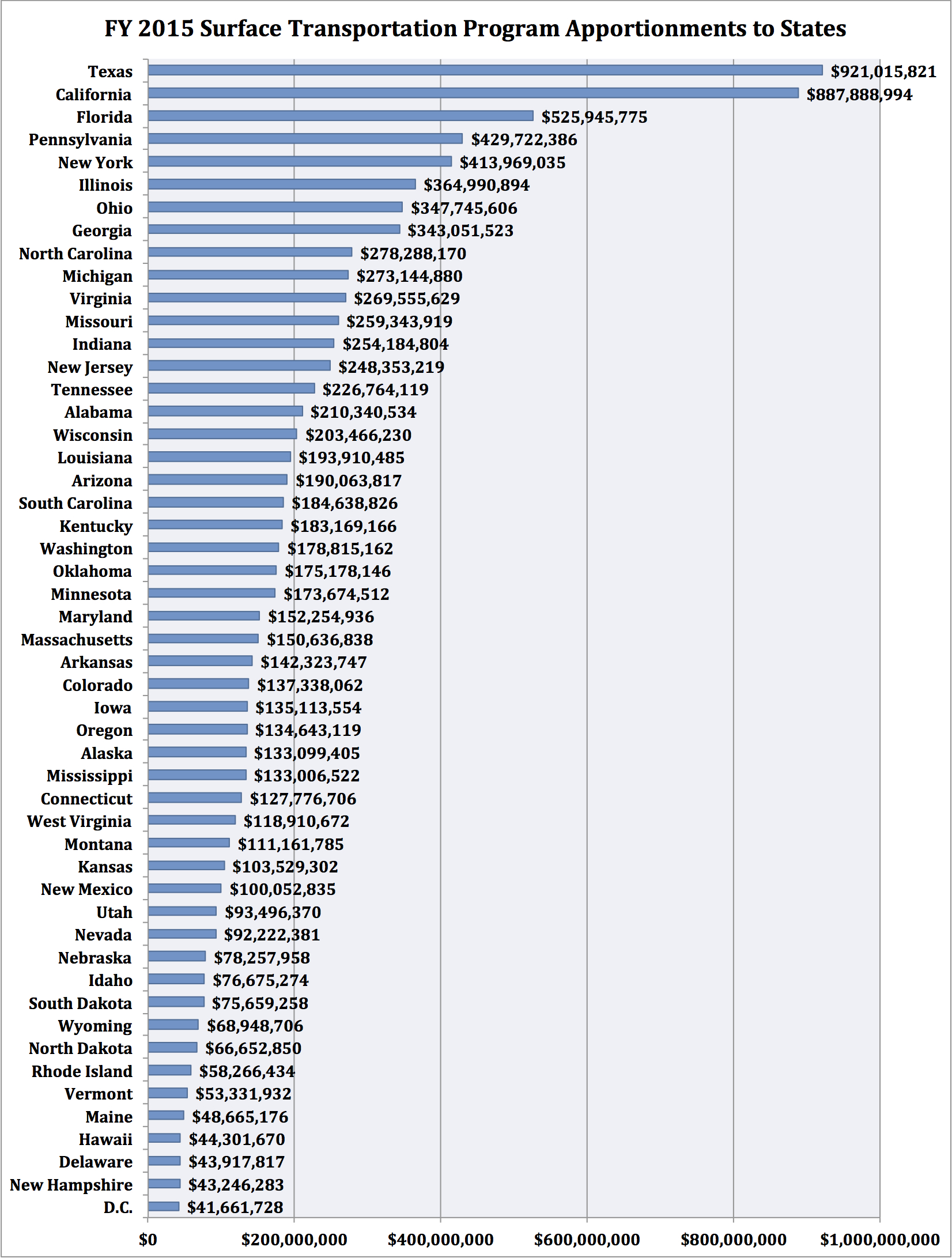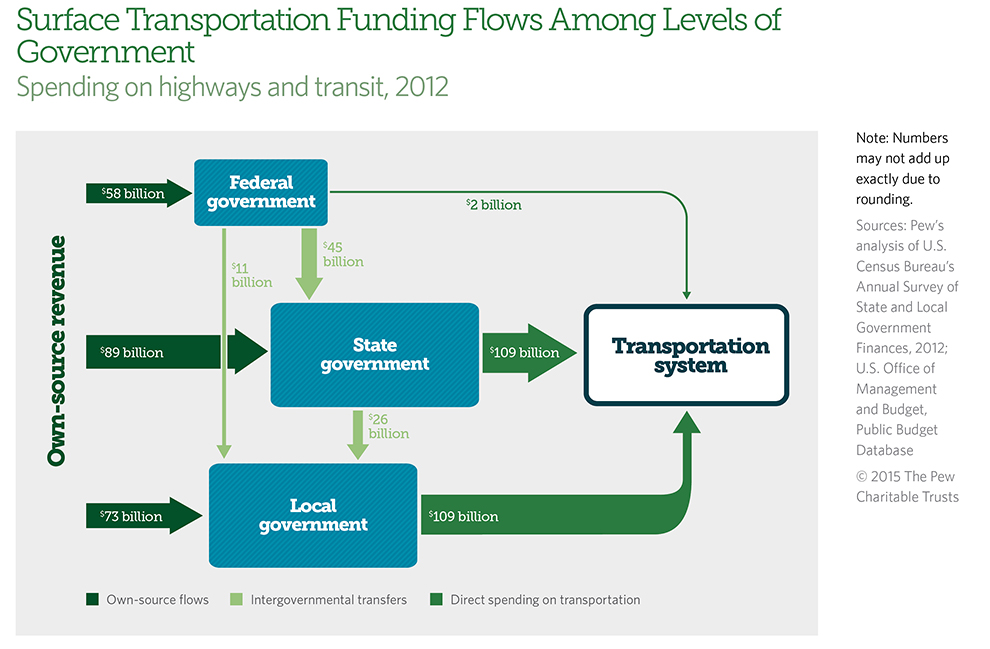Connecting state and local government leaders
Looking at the priorities for state capitals and city halls in a proposed six-year $325 billion transportation bill in the U.S. House.
As multi-year transportation legislation continues to take shape in Congress, observers at the state and local level are closely watching provisions that would increase the share of money flowing to local governments, while lowering the proportion states have at their disposal.
A bill that proposes spending up to $325 billion on transportation over the next six years could be up for consideration on the floor of the House of Representatives as early as this week. In July, a $350 billion transportation measure passed in the Senate.
Both bills include language that would shift the balance of funds distributed under what’s known as the Surface Transportation Program to favor local areas over states.
Leaders at the local level, including big-city mayors, have been vocal about their desire to see greater local control over federal funds going to states. But some at the state level take a critical view of the shift in the transportation bills.
The Surface Transportation Program provides a flexible source of funding for states and localities to use for a wide variety of transportation expenses, including those involving roads, public transit and infrastructure for pedestrians and cyclists.
Jessica Monahan, associate legislative director for transportation at the National Association of Counties, described the program as “the bread and butter for local governments” when it comes to federal transportation funding.
As it stands, 50 percent of the money each state receives under the Surface Transportation Program must be divided among local areas based on the size of their population.
States can use the other half as they see fit, but are required to set aside federally mandated portions for certain things—15 percent has to go toward bridges, for example.
Both the House and Senate bills would increase the ratio of the money that flows to localities to 55 percent. In the House bill the increase would be phased in, rising by 1 percent annually. For local areas, the split still falls short of the 62.5 percent share of this money that they enjoyed under federal transportation policies in place prior to 2012.
How much cash is at stake?
In fiscal year 2015, the program was allotted about $10.3 billion, according to the U.S. Department of Transportation. These funds were allocated across all 50 states and the District of Columbia. For instance, Texas was allowed $921,015,821.
Route Fifty article continues below ...

According to an analysis from the American Road & Transportation Builders Association, the six-year amount of highway and transit funding authorized under the Surface Transportation Program in the Senate bill is around $64.5 billion. An analysis of the House bill pegs the funding level at around $65.4 billion.
These figures do not include money for the Federal Motor Carrier Safety Administration and National Highway Traffic Safety Administration, so they’re shy of the program’s actual total.
How the pie of Surface Transportation Program dollars gets sliced is one important aspect of the transportation legislation for state and local governments, but there are others as well.
Among them are proposals that have so far been left out of the House and Senate bills, which are designed to give smaller-sized local jurisdictions more influence over how states invest their share of the local Surface Transportation Program money.
Currently, only local areas with more than 200,000 people can exert direct control over how the funds get used, while states are free to identify how the local money will be spent in places with fewer people.
“Right now, a local community can say: ‘Hey, here are our priorities,” explained Stephen Davis, communications director at Transportation for America, an advocacy group that pushes for walkable and transit-oriented development. “The state can say: ‘Well, that’s great, we’re going to widen the state highway that runs near your town.’”
An amendment from U.S. Reps. Dina Titus, a Nevada Democrat, and Rodney Davis, an Illinois Republican, aims to give areas with smaller populations more of a role in determining how the local Surface Transportation Program money gets spent. It would also raise the local share of the program’s money to 60 percent—instead of 55 percent—in increments, during the six years the bill covers.
Route Fifty article continues below …
RELATED from The Pew Charitable Trusts: “Short-term Highway Trust Fund Extensions Complicate Planning for States”

Route Fifty article continues ...
It was among dozens of amendments House lawmakers submitted on Friday to the chamber’s Committee on Rules. On Monday, the committee is scheduled to meet, and could decide then which of these amendments will be considered by the House, and which will not.
Another major concern for many of those with an interest in the legislation are unanswered questions about revenue. Both bills include six years of spending, but where the revenue to pay for it will come from after the first three years is still unclear.
Long-Term Bill Seen as Crucial
Organizations that represent state lawmakers, county governments and cities, all generally seem to share one sentiment: specific provisions aside, getting a multi-year bill approved is critically important for both states and localities.
“The worst thing that could happen is that the process falls apart and they end up doing some kind of extension to get us through the election,” said Michael Wallace, program director for community and economic development at the National League of Cities.
Congress has passed 35 short-term extensions of transportation programs since 2009. President Obama signed the most recent one on Oct. 29. It will last until Nov. 20.
“What cities really need, and what states need, and what the whole country needs, is the certainty that a six-year bill is going to provide,” Wallace added.
The absence of a long-term bill has created uncertainty at the state and local level about the availability of federal funding for highway and transit projects, some of which can take years to plan and build.
And without a multiyear bill in place, some states have chosen to put off projects.
Citing uncertainty over federal funding, Georgia’s Department of Transportation on Oct. 22 announced the postponement of December bidding for 34 projects valued at $123 million.
“It has been ten years since Congress has been able to pass a transportation funding bill of more than a two-year duration,” Georgia DOT Commissioner Russell McMurry said in a statement issued with the announcement. “We can’t do long-term transportation planning with short-term funding fixes.”
The State-Local Funding Shift

Ben Husch is the director of the Natural Resources and Infrastructure Committee at the National Conference of State Legislatures. “To NCSL the most important thing is a long-term fully-funded bill,” he said.
But on the topic of shifting more Surface Transportation Program money toward localities, he notes: “We oppose the expansion of federal to local funding sources.”
The NCSL, he said, supports maintaining the current 50-50 split, and believes redirecting a larger share of the program’s funds to localities would “negatively impact the ability of states to invest in certain transformative transportation projects.”
The National Association of Counties, on the other hand, endorses redirecting the funds.
But there’s an aspect of the Senate bill the group does not like. It has to do with the 15 percent of Surface Transportation Program funding that states now have to set aside for bridge projects.
Under current law, the chunk of money set aside for bridges comes strictly from the state side of the program. The Senate bill stands to change this, taking the money off the top, and reducing the overall size of the pot by 15 percent before localities are allotted their share.
So even though local governments would see their portion of the program funds rise to 55 percent, some of this increase would get chewed up by the new bridge mandate.
The House legislation does not make a similar change to bridge funding requirements.
“This issue is a major factor in how we look at these two bills,” NACo's Monahan said.
She added: “When we’re talking about 55 percent on the House side, we’re talking about 55 percent of 100 percent of the pie.”
National Association of Counties estimates show that compared to the Senate bill, the House bill would deliver an additional $5 billion of Surface Transportation Program funding to local areas, over the six year duration of the bill.
One side note is that in the House bill, the Surface Transportation Program is renamed the Surface Transportation Block Grant Program.
Wallace, of the National League of Cities, said the group “would love to see more direct funding restored to local governments,” but he also noted: “We’re not trying to compete for funding with the states, because cities need interstates just like anybody else.”
“For us,” he said, “it’s more a question of: ‘This is why we need to solve revenue side of the picture.’”
Six Years of Spending, Three Years of Funding
With both bills, the revenue side of the picture remains a bit murky.
“Saying that this is a long term bill, because they say it’s a six year bill, they have six years of policy, is a little misleading,” said Transportation for America's Davis.
“They have three years of funding,” he added. “We don't even know where the three years of funding will come from in the House.” Referring to state and local governments he cautioned: “What they may find out is that they only have a three year bill.”
Revenue flowing into the federal Highway Trust Fund, a key account for the transportation money that goes to states and localities, has consistently fallen short in recent years. Money for the fund is mainly generated through taxes on motor fuels, including gasoline and diesel.
According to information The Pew Charitable Trusts published in February, gas tax revenue has been falling over the last decade, primarily due to more fuel-efficient cars and changing driving habits. The federal gas tax itself has remained at 18.4 cents per gallon since 1993.
The analysis from the American Road & Transportation Builders Association notes that the pending House bill includes a provision that would prohibit the Secretary of Transportation from granting the final three years of funding authority to the states, unless subsequent legislation is passed to ensure that the trust fund has sufficient money to support the cost of doing so.
Also noted in the analysis is that the House bill “does not yet include any new trust fund revenues” which means “its first three years of surface transportation authorizations are just as unsupportable as are its final three years.”
The Senate bill provides three years of guaranteed funding for the Highway Trust Fund.
But Davis, like others, expressed skepticism about some of the revenue mechanisms in the bill, such as selling off oil from the nation’s Strategic Petroleum Reserve.
“We haven't had a serious, grownup conversation about the need for more funding to keep the trust fund solvent,” Davis said. “Flipping over the couch cushions and performing accounting maneuvers to be able to say we’ve got enough money is just a little disingenuous.”
Giving Smaller Areas More Sway
Bipartisan proposals put forward in the House and Senate to give areas with less than 200,000 people more influence over how their portion of the local Surface Transportation Program dollars get spent have so far not gotten much traction.
An amendment proposed by U.S. Sens. Roger Wicker, a Mississippi Republican, and Cory Booker, a New Jersey Democrat, who is the former mayor of Newark, called for the creation of a transparent and competitive grant program to guide the distribution of funds to smaller areas.
The amendment would have also upped the proportion of Surface Transportation Program money for localities to 67 percent.
It was left out of the Senate bill.
“We definitely think there’s still a way forward,” a Democratic aide said this week, referring to the amendment. The aide added that he believed the language in the proposal would be on the table if the House and Senate end up brokering a final version of the transportation legislation.
An aide in Wicker's office said the senator would continue to fight for the language to be included in a final bill. Asked if he thought it would be difficult, he said: “I wouldn’t argue that point.”
The House amendment from Reps. Titus and Davis mirrors the one offered by Wicker and Booker. It calls for states to coordinate with smaller areas when deciding how to use Surface Transportation Program funds, and to publish procedures for how local governments and other organizations in smaller areas can apply for the funding.
The amendment would also require states to publish information online about the applications for funding they receive, and which projects were funded.
At least 179 amendments related to transportation provisions in the House bill were submitted Friday to the Committee on Rules.
Wallace, of the National League of Cities, noted that if a six-year bill wins final approval in Congress there would be future chances for cities, and other groups, to work with lawmakers to iron out any shortcomings. “The most important thing,” he said. “is just to get the long term bill done.”
Bill Lucia is a Reporter for Government Executive’s Route Fifty.

NEXT STORY: Short-term Highway Trust Fund Extensions Complicate Planning For States




